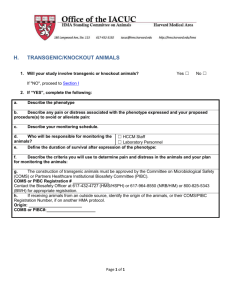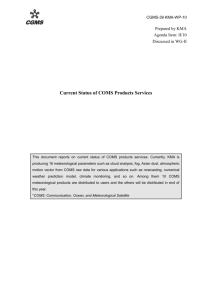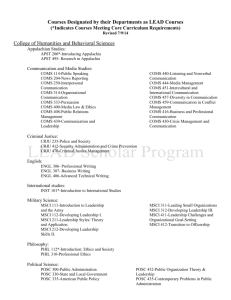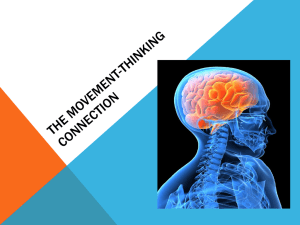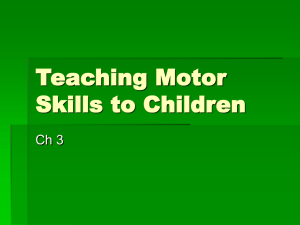Orientation and Mobility - Association for Education and
advertisement
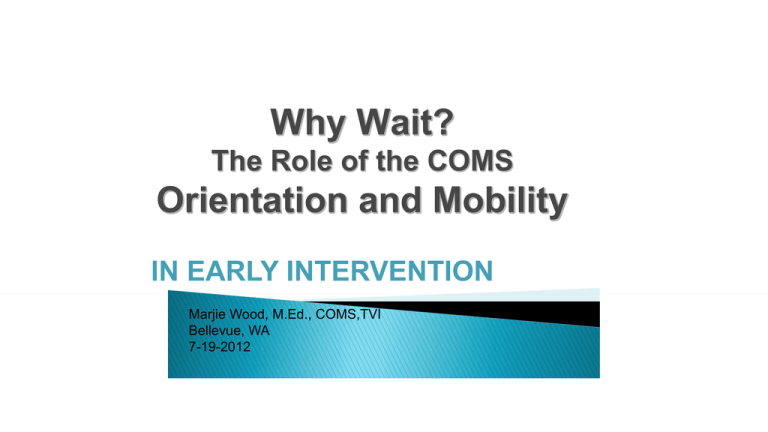
Why Wait? The Role of the COMS Orientation and Mobility IN EARLY INTERVENTION Marjie Wood, M.Ed., COMS,TVI Bellevue, WA 7-19-2012 History of O&M Late 1940’s -began after WWII to aid blinded veterans st 1960- 1 O&M University Program Started 1970’s- O&M for 3-21 year olds in public schools History of O&M (cont.) The late 1970’s O&M instruction included infants and toddlers in the public schools First time as a related service, IDEA 1997 Since the early 90’s, O&M instruction for children from birth through 22 years of age has been provided on an itinerant basis in Texas public schools. What is Orientation and Mobility? Federal Law - IDEA B 1997 Orientation and mobility services means, “services provided to blind or visually impaired students by qualified personnel to enable those students to attain systematic orientation to and safe movement within their environments in school, home, and community; and includes teaching students the following as appropriate: Spatial and environmental concepts and use of information received by the senses IDEA – Part B (cont.) (such as sound, temperature and vibrations) to establish, maintain, or regain orientation and line of travel (for example, using sound at a traffic light to cross the street); • To use the long cane, as appropriate, to supplement visual travel skills or as a tool for safely negotiating the environment for students with no available travel vision; • To understand and use remaining vision and distance low vision aids, as appropriate; and • Other concepts, techniques, and tools as determined appropriate.” [34 CFR 300.24(b)(6)] IDEA Part C 9-28-2011 ) (17) Vision services mean— (i) Evaluation and assessment of visual functioning, including the diagnosis and appraisal of specific visual disorders, delays, and abilities that affect early childhood development; (ii) Referral for medical or other professional services necessary for the habilitation or rehabilitation of visual functioning disorders, or both; and (iii) Communication skills training, orientation and mobility training for all environments, visual training, and additional training necessary to activate visual motor abilities. IDEA Part C (cont.) 303.13(c)(5) Qualified personnel. The following are the types of qualified personnel who provide early intervention services under this part: (1) Audiologists. (2) Family therapists. (3) Nurses. (4) Occupational therapists. (5) Orientation and mobility specialists. (6) Pediatricians and other physicians for diagnostic and evaluation purposes. (7) Physical therapists. (8) Psychologists. (9) Registered dieticians. (10) Social workers. (11) Special educators, including teachers of children with hearing impairments (including deafness) and teachers of children with visual impairments (including blindness). (12) Speech and language pathologists. (13) Vision specialists, including Ophthalmologists and optometrists http://www.gpo.gov/fdsys/pkg/FR-2011-09-28/pdf/2011-22783.pdf Orientation and Mobility “ For the very young child, mobility refers to general gross motor development, including the normal integration of reflexes, acquisition of motor milestones, refinement of quality-of-movement skills, and purposeful, self-initiated movement” ( Pogrund and Fazzi, Eds., 2002, p.328). 1. Where am I? Body in space (O) 2. Where am I going? Body in space(O), spatial understanding(O) and safety in movement ( O & M) 3. How will I get there? Spatial understanding (O & M) The Role of the COMS in the Early Intervention Team Orientation- ◦Where Am I? 1) vestibular 2) proprioception 3) visual 4) auditory 5) tactile/ haptic sense 6) olfactory The Role of the COMS in the Early Intervention Team 1. Vestibular- A. Composed of 3 structures in the inner ear which register 1. the speed, force, and direction of movement, 2. the effect of gravity on the body, and 3. head and body position. B. Assists in the regulation of muscle tone, coordination, balance, and equilibrium C. Fully functional at birth and the first sensory system to mature D. “ Visual impairments affect how the vestibular system develops, how vestibular input is registered and used which can lead to low postural tone, delayed balance reactions, and delayed motor development” (Anthony, Brown, Lowry and Hatton, 1994, p. 157) The Role of the COMS in the Early Intervention Team 2. Proprioception- A. The receptors located in the tendons, muscles, and joints. B. Provides information regarding the orientation of the body in space and the relation of body parts to each other. C. Plays a role in balance, postural tone development, posture and haptic perception( ability to tactually identify objects). D. Provides information about the body when it is static, e.g. lying, sitting, or standing. E. Provides the only means to identify and precisely coordinate movement for those who are blind The Role of the COMS in the Early Intervention Team 3. Vision- ◦ A. One of the 2 distance senses ◦ B. The first 2 years of life are particularly influenced by children’s visual environment(Anthony, Brown, Lowry, and Hatton, 2004). ◦ C. “Without vision, learning motor skills through imitation is extremely difficult. They cannot learn by watching and have to be introduced to most fine and gross motor tasks. Even then, children with visual impairments sometimes exhibit different ways of moving or a different quality of movement” (Pogrund and Fazzi, Eds., 2002). ◦ D. “Children with visual impairments do not have the opportunity of incidental learning. They do not have the benefit of vision as a unifying sense to assist in learning the meaning sounds, the functions of objects, and help in organizing their world” (Pogrund and Fazzi, Eds. 2002). The Role of the COMS in the Early Intervention Team 4. Auditory- ◦ A. The other distance sense B. 3 levels of hearing 1. primitive- breathing, swallowing, chewing and familiar background sounds 2. signal warning- monitoring the environment- in conjunction with vision 3. spoken communication(speech)-develops naturally due to the child’s ability to hear; “a great deal of listening does and indeed must occur (14-16 months) before verbal output can occur” (Flexer, 1999, p.16) C. “ A mild hearing loss ( associated with frequent ear infections) can affect a child’s language development during the first years of life” (Anthony, Brown, Lowry, and Hutton, 2001, p. 142). The Role of the COMS in the Early Intervention Team 5. Tactile- A. Refers to stimulation reaching the central nervous system from receptors in the skin B. Most mature sense at birth and first to emerge in utero C. Activates most of the newborn reflexes (rooting reflex) D. Children with visual disabilities must use their hands to gain information about the world. E. Six types of sensory information detected through touch: deep touch, light touch, vibration, pain, temperature control and two-point touch ( ability to identify how many points of contact an object has on skin, e.g. braille cells) F. Haptic sense- the ability to recognize an object by touch The Role of the COMS in the Early Intervention Team Movement ◦ “Many factors such as neural maturation, the environment, biomechanics, kinesiology, perception, learning, and goal-directed behavior influence movement” (Alexander, Boehme, & Cupps, 1993; Bly, 1994; Shumway-Cook @ Woolacott, 2001: Ulrich, 1997). ◦ “Movement facilitates early development. Young children’s movement not only affects motor development, but also plays a major role in the development of cognition, social-emotional relationships, and communication” (Anthony, Brown, Lowry and Hatton,1994, p. 351). The Role of the COMS in the Early Intervention Team The COMS’ role is to: Encourage early purposeful and self-initiated movement in children who are visually impaired and continue as children move through and explore increasingly complex environments (Pogrund and Fazzi, Eds., 2002). Video of 2 year old transitioning from floor to couch 18 The Role of the COMS in the Early Intervention Team COMS’ role is to: ◦ Encourage early purposeful and self-initiated movement ; The 19 Vision Team Roles in Early Intervention TVI COMS Provides hand under hand instruction in play, activities of daily living, and pre-literacy Helps structure the home environment for beginning orientation and safety, provides activities. instruction to encourage safe and purposeful movement. “Brings the world to the child” - training for all environments, visual training, and additional training necessary to activate visual motor abilities- IDEA PART C “Brings the child to the world” The VI Team in Early Intervention Child O&M VI The Interrelationship of the TVI, COMS, and OT TVI COMS OT The Interrelationship of the Early Intervention (EI) Service Providers (Large circle rep. the EIS and SLP) TVI COMS OT PT Early Identification and Intervention is Crucial Children who are visually impaired and their families need specialized instruction and educational guidance from professionals who have expertise in addressing their disability-specific needs. (Pogrund, R.L. & Fazzi,D.L. Eds. 2002). Current Students Who Have Received Early Intervention Services photo goes here 25 Video of 4 year old learning to jump rope 26 Video of student playing on equipment in gym 27 Video This is a video of a child who has a cortical visual impairment and other multiple disabilities. You will see examples of 2 different O&M routines which encourage body awareness and purposeful movement. Video of Motor Music Routine and Swinging Routine 29 Resources Alexander, R., Boehme, R., & Cupps, B. (1993). Normal development of functional motor skills: The first year of life. Tucson, AZ: Therapy Skill Builders. Anthony, T., Brown, C., Lowry, S., and Hatton, D. (1994). Developmentally Appropriate Orientation and Mobility (pp.127-157, 351). University of North Carolina at Chapel Hill, NC: FPG Child Development Institute. Blye, S. (1994). Multivariate data mappings. In G. Kramer (Ed.), Proceedings of the International conference on Auditory Display 1992. Auditory display: Sonification, audification, and auditory interfaces. Reading, MA: Addison-Wesley Resources Flexer, C. (1999). Facilitating hearing and listening in young children (2nd ed.) San Diego, CA: Singular Publishing Group. Shumway-Cook, A., @woollacott, M.H. (2001). Motor Control (2nd. ed.). Baltimore: Lippincott, Williams & Wilkins Ulrich, B.D. (1997). Dynamic systems theory and skill development in infants and children. In K.J. Connolly & H. Forssberg (Eds.), Neurophysiology and neuropsychology of motor development ( pp. 319-345). Cambridge, U.K.: Cambridge University Press. Pogrund, R.L., & Fazzi, D.,Eds.(2002). Early Focus: Working with Young Children Who Are Blind or Visually Impaired and Their Families, 2nd Ed. New York: American Printing House for the Blind
